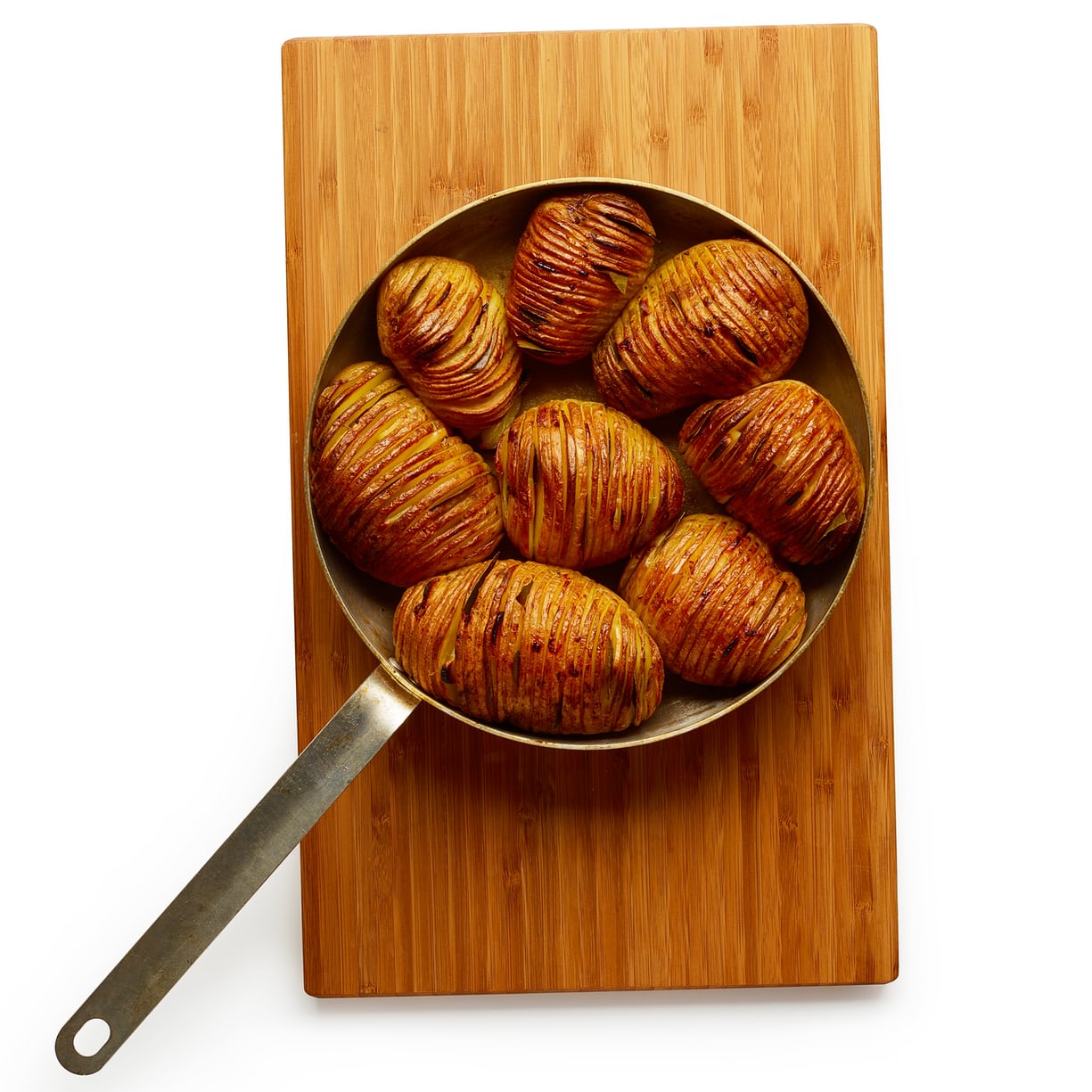How to make the perfect hasselback potatoes
These spuds look a lot more work than they are. But it's important to follow a few simple steps to achieve that crisp, buttery and Instagrammable end result
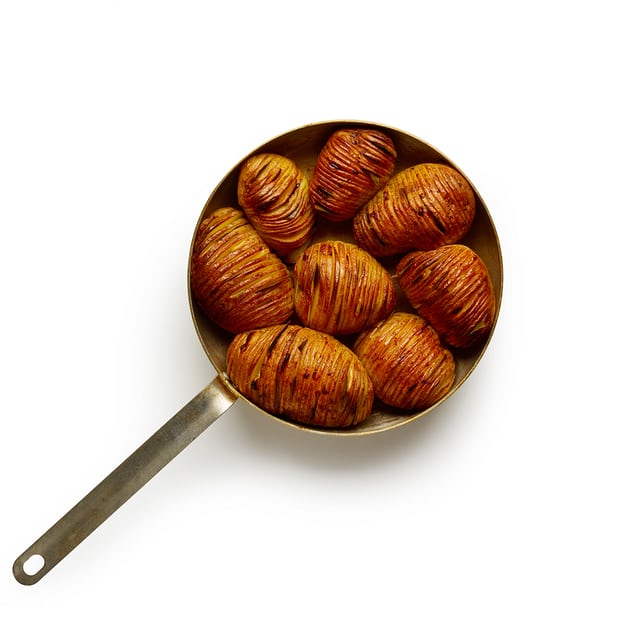
Felicity Cloake's perfect hasselback potatoes. Photograph: Dan Matthews for the Guardian
Hasselback potatoes, named after the Stockholm restaurant said to have created them, are one of those dishes that tend to look better than they taste: painstakingly chiselled fans of gloriously golden carbohydrate perfect for the Instagram age, yet sadly soggy on the fork. As Ed Smith writes in On the Side, "disappointingly, some so-called hasselback potatoes turn out to be little more than roast new potatoes with a few cuts in them", when they should be a showstopping cross between a roast potato and a fried one, both comfortingly fluffy and satisfyingly crunchy. They may be more work than a pan of mash and not, perhaps, the kind of thing you'd knock up on a Tuesday evening, but if you're out to impress, hasselbacks are the perfect accompaniment to steak, roast chicken, meaty fish or just about anything else that might demand a helping of chips – and they're considerably easier to execute, too. Plus, did I mention they look good on Instagram?
You say po-tay-to, I say po-tah-to

Ed Smith's hasselback potatoes. Photograph: Felicity Cloake for the Guardian
Not everyone thinks that hasselbacks should be fluffy: Nigella Lawson writes that she loves them made with new potatoes, too, recommending charlotte or ratte, choices echoed by Smith, Stevie Parle and Trish Hilferty in her book Lobster and Chips, which calls for "medium-sized waxy potatoes".
Ranged against them are Martha Stewart (her yukon golds, like Julia Moskin's russets, are hard to get hold of in this country, but seem to be classified as "fluffy" by the British Potato Council, so I substitute Roosters), and Alastair Little, who calls for baking potatoes, which also get an airing in Moskin's recipe, mainly because I can find no other spuds weighing a pound each.
Alhough I don't think such huge potatoes are the best suited for the hasselback treatment, because the crisp exterior to fluffy interior ratio is all wrong, I do prefer their fluffy texture to the smoothness of the waxy kind, which, soaked in butter, are almost too rich for my taste – more like fondant potatoes. Like chips and roast potatoes, fluffy seems the way to go.
Peeling and cutting

Alastair Little's hasselback potatoes. Photograph: Felicity Cloake for the Guardian
I'm pleased to discover that peeling the potatoes is traditional, but not mandatory: Little and Hilferty are the only ones to bother. In theory, it should help the exterior crisp up, but in practice it doesn't seem to make much difference, and leaving the skins on gives the dish a better flavour.
It does pay, however, to spend time on the cutting of the potatoes. Many of the recipes dictate slicing them in 5mm intervals, but, in the hope of speeding up the cooking process, I'm going to copy Smith's 2-3mm intervals, which also have the (possibly questionable) benefit of making the potatoes look like oversized woodlice. To help you slice down, but not through them, you could run a skewer through their length, as Hilferty and Little recommend, or cut them between two chopsticks, like Parle, but I find the simplest way is to put the potatoes in the bowl of a wooden spoon, as Molly Wizenberg suggests on her blog Orangette. As potatoes are not a uniform diameter along their entire length, slicing at a slight angle, à la Little, often makes life easier.
Rinsing off some of the surface starch, a tip from Hilferty, does seem to help stop them sticking together; Little's cold water bath presumably serves the same purpose, but running water proves more effective.
The cooking
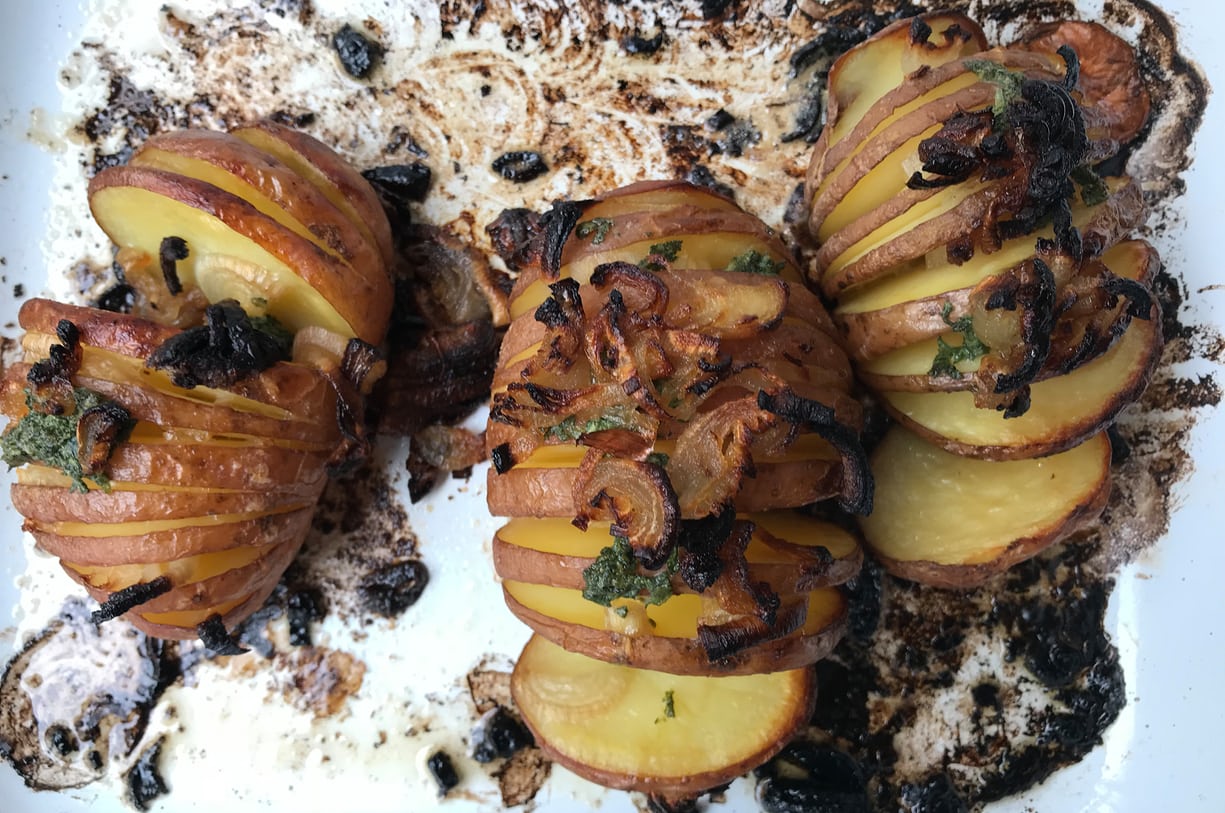
Martha Stewart's hasselback potatoes. Photograph: Felicity Cloake for the Guardian
Moskin's is the only recipe to pre-cook the spuds, boiling the monsters for 10 minutes, then allowing them to cool completely before baking. Athough this proves inconvenient, the idea isn't a bad one: potatoes are dense things, and many of the recipes I try wildly underestimate the baking time, so it makes sense to give them a head start. However, I prefer Smith's method of braising them in water in the oven itself: although the bottoms might not be quite as crunchy as those roasted just in butter, the tops still crisp up satisfactorily, and there are no questionable bits of semi-raw spud in the middle.
The oven should be hot, but not too hot – Moskin's 220C/425F/gas 7 leaves the potatoes charred on top before they've had a chance to cook through – and it's essential, as most recipes acknowledge, to keep basting them throughout the cook, "in order for the butter to penetrate", as Parle puts it.
The flavourings

Stevie Parle's hasselback potatoes. Photograph: Felicity Cloake for the Guardian
Butter is the order of the day here – and lots of it. You could substitute olive oil, if you'd prefer to keep them vegan, or swap in duck or goose fat or even good beef dripping, but, for me, potatoes and butter are a match made in heaven. You don't need anything else, but garlic goes well with butter, of course, and also has the benefit of helping to wedge the slices open. If you don't like garlic, shallots or onions work just as well, or you could use bay leaves or sage, but be careful not to overdo it, because a little goes a long way with both.
Smith also adds caraway seeds, and Moskin sweet and smoked paprika intended to replicate the smoky bacon she reckons the originals were wrapped in, but I find no mention of this elsewhere. It does indeed give her potatoes a "gorgeous ruddy colour", however, and would be lovely with roast pork or barbecued meat or veg.
A recipe from Swedish restaurateur Leif Mannerström calls for the baked hasselbacks to be finished with breadcrumbs and potentially parmesan cheese. I like the extra crunch the former adds, but feel free not to bother: they'll still be utterly delicious, whether you're serving them with a leg of lamb or on their own with a bowl of wild garlic mayonnaise. (Interested parties may like to know that, in the writing of this piece, several people recommended Yotam Ottolenghi's hasselback gratin to me: it didn't seem to fit with the remit, but it does look amazing.)
Perfect hasselback potatoes
- Prep 15 min
- Cook 1 hr 30 min
- Serves 4
- 8 medium floury potatoes, such as maris pipers or king edwards (about 800g-1kg)
- 6 garlic cloves, peeled
- 3 bay leaves (optional)
- 50g butter
- 2 tbsp dry breadcrumbs, tossed with a little olive oil (optional)
Heat the oven to 200C/390F/gas 6. Find an ovenproof frying pan or a heavy, hob-safe baking tin that's just large enough to hold the potatoes in a single layer.
Put each potato in the bowl of a wooden spoon and, at roughly 2mm intervals, cut carefully down, but not quite through, the potato, maintaining a slight angle towards the centre of the potato.
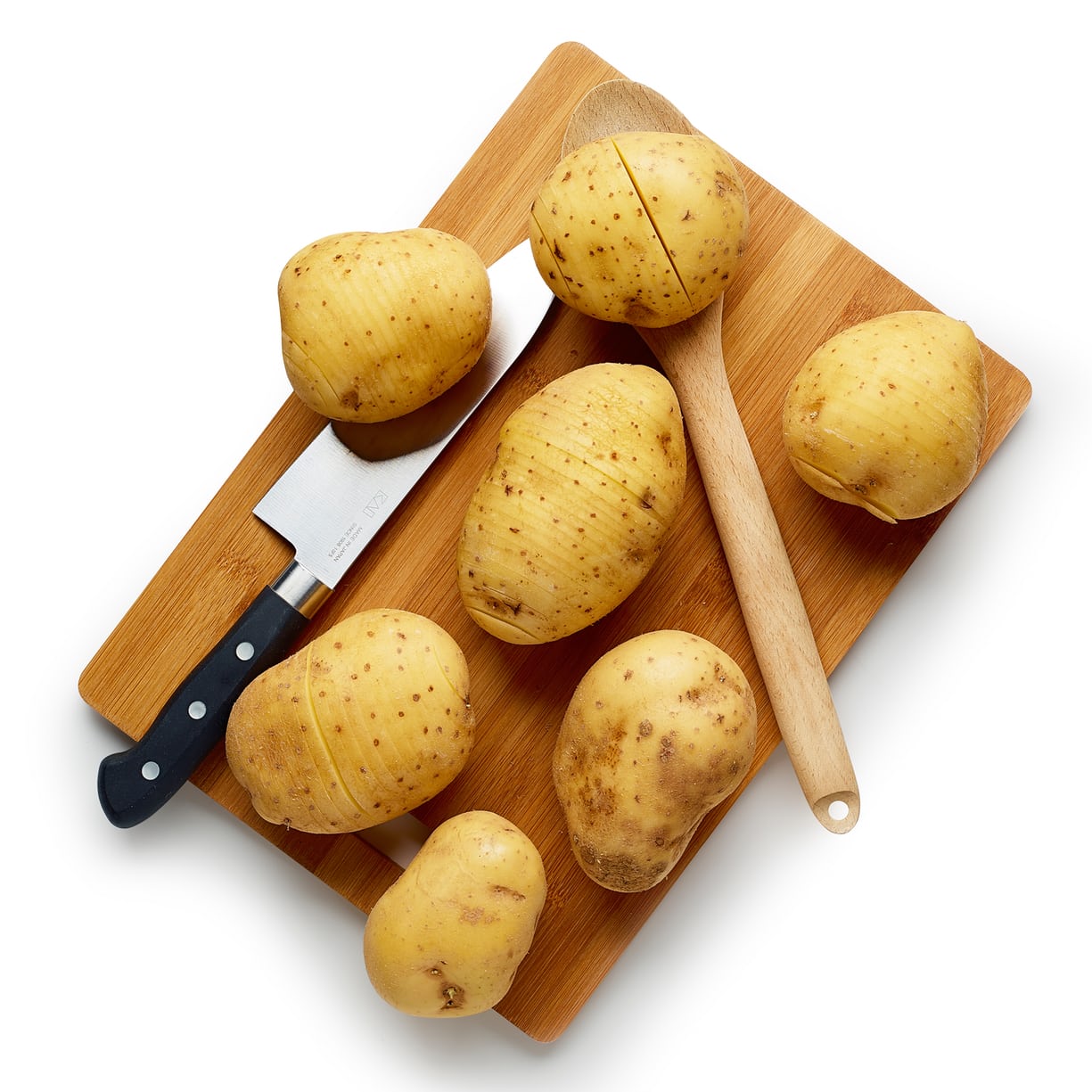
Cut into each potato, being careful not to cut all the way through. Photograph: Dan Matthews for the Guardian
Slice the garlic, and stuff several pieces into each potato, making sure you push them well down so they don't burn. Tear the bay leaves, if using, into several pieces and do the same.
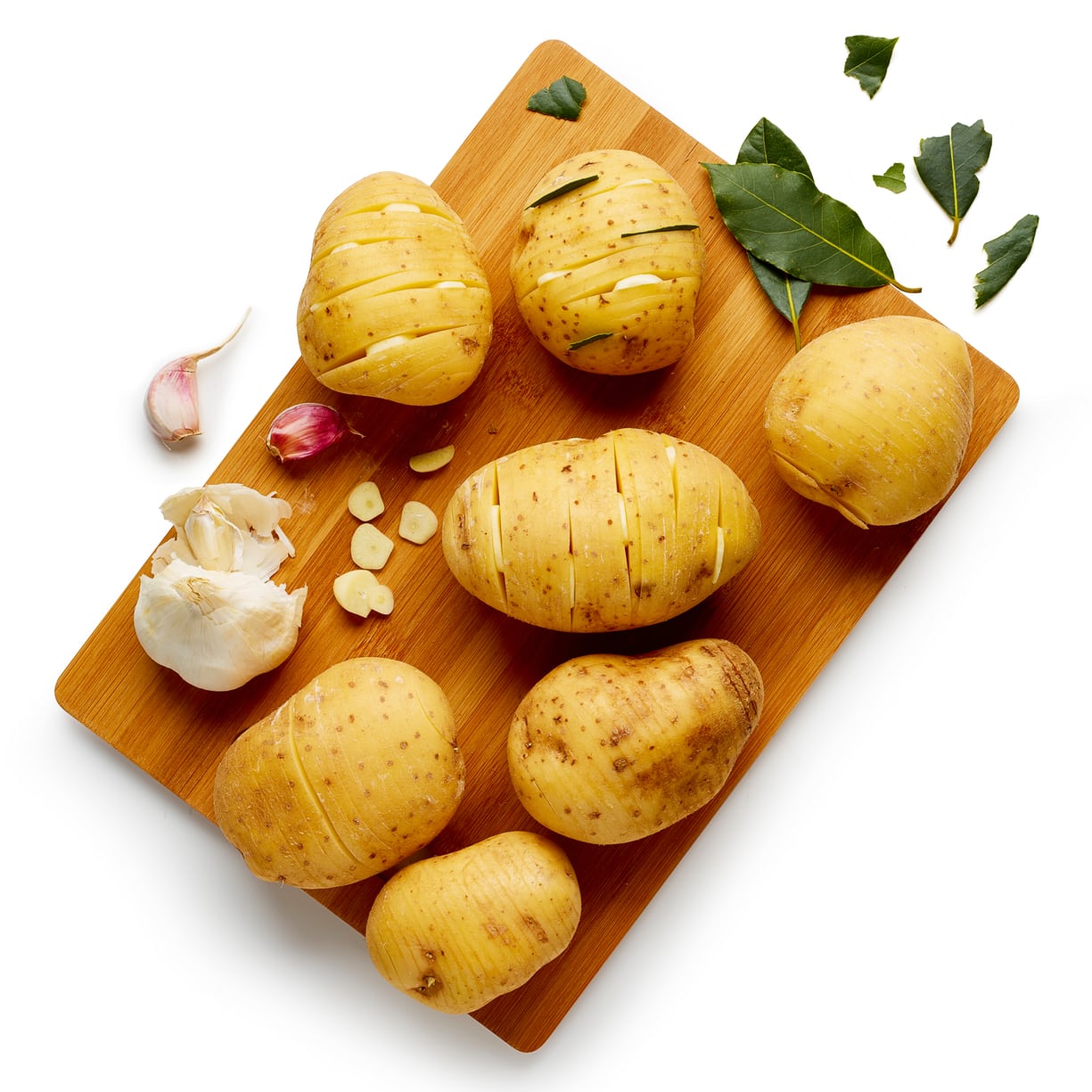
Fill the slices with garlic or bay for flavour.
Meanwhile, melt the butter in the pan or tin over a medium heat until sizzling. Put in the potatoes one by one, and carefully turn them in the butter to coat, then pour in enough cold water to come halfway up the sides of the potatoes.
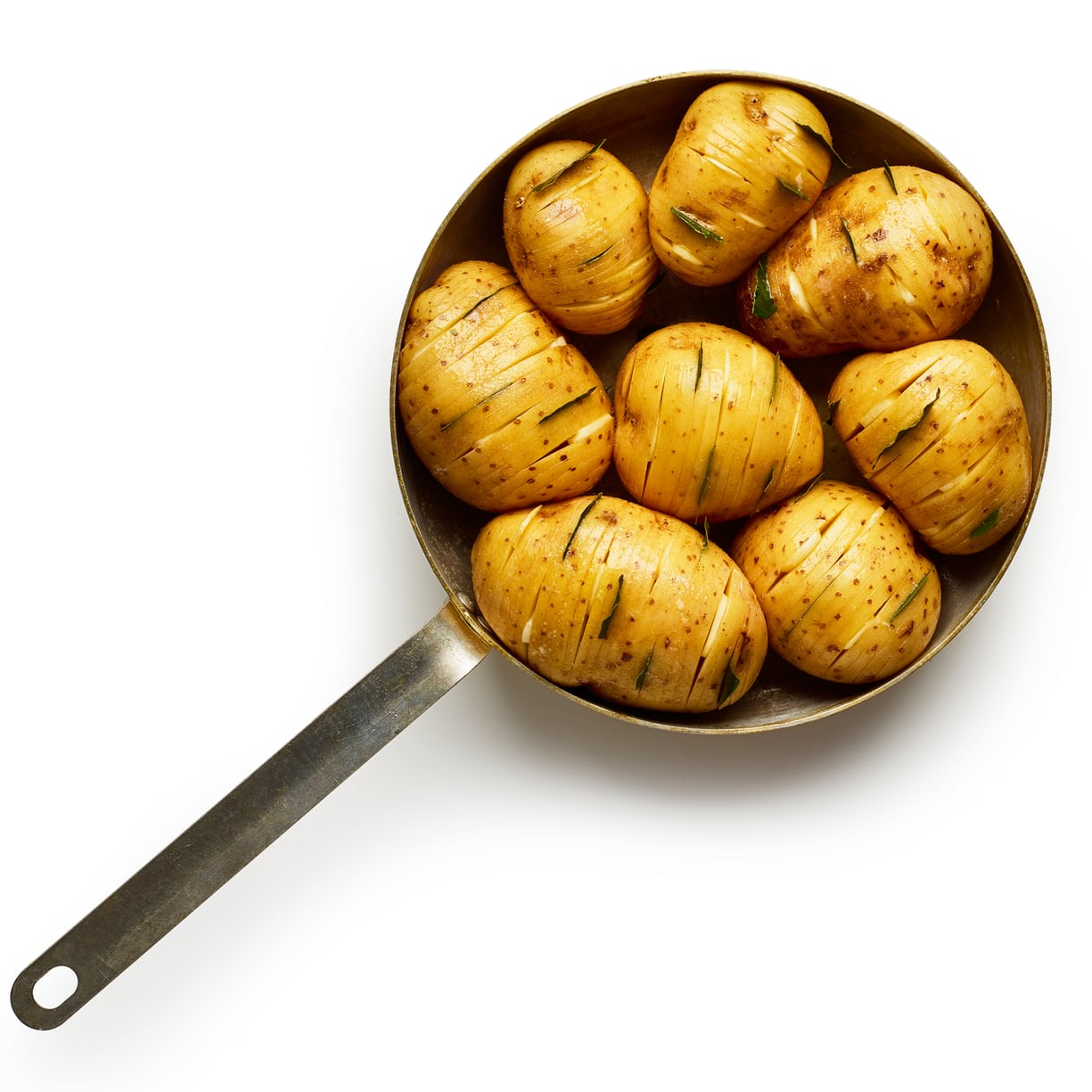 Coat the potatoes with butter, add some water and bring to a boil on the hob.
Coat the potatoes with butter, add some water and bring to a boil on the hob.
Bring to a boil, then roast for an hour and 30 minutes, basting every 15 minutes. Scatterwith the breadcrumbs, if using, for the final 15 minutes of cooking, at which point you can add any remaining garlic to the pan as well. Serve hot from the oven.
